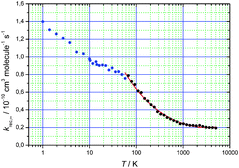SACM/CT Study of the dissociation/recombination dynamics of hydrogen peroxide on an ab initio potential energy surface
Part II. Specific rate constants k(E,J), thermal rate constants k∞(T), and lifetime distributions†
Abstract
Statistical adiabatic channel model/classical trajectory (SACM/CT) calculations of the dissociation/recombination dynamics of


 Please wait while we load your content...
Please wait while we load your content...